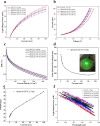Effect of strain relaxation on performance of InGaN/GaN green LEDs grown on 4-inch sapphire substrate with sputtered AlN nucleation layer
- PMID: 30837579
- PMCID: PMC6401382
- DOI: 10.1038/s41598-019-40120-9
Effect of strain relaxation on performance of InGaN/GaN green LEDs grown on 4-inch sapphire substrate with sputtered AlN nucleation layer
Abstract
Here we demonstrate high-brightness InGaN/GaN green light emitting diodes (LEDs) with in-situ low-temperature GaN (LT-GaN) nucleation layer (NL) and ex-situ sputtered AlN NL on 4-inch patterned sapphire substrate. Compared to green LEDs on LT-GaN (19 nm)/sapphire template, green LEDs on sputtered AlN (19 nm)/template has better crystal quality while larger in-plane compressive strain. As a result, the external quantum efficiency (EQE) of green LEDs on sputtered AlN (19 nm)/sapphire template is lower than that of green LEDs on LT-GaN (19 nm)/sapphire template due to strain-induced quantum-confined Stark effect (QCSE). We show that the in-plane compressive strain of green LEDs on sputtered AlN/sapphire templates can be manipulated by changing thickness of the sputtered AlN NL. As the thickness of sputtered AlN NL changes from 19 nm to 40 nm, the green LED on sputtered AlN (33 nm)/sapphire template exhibits the lowest in-plane compressive stress and the highest EQE. At 20 A/cm2, the EQE of 526 nm green LEDs on sputtered AlN (33 nm)/sapphire template is 36.4%, about 6.1% larger than that of the green LED on LT-GaN (19 nm)/sapphire template. Our experimental data suggest that high-efficiency green LEDs can be realized by growing InGaN/GaN multiple quantum wells (MQWs) on sputtered AlN/sapphire template with reduced in-plane compressive strain and improved crystal quality.
Conflict of interest statement
The authors declare no competing interests.
Figures





Similar articles
-
Effects of GaN/AlGaN/Sputtered AlN nucleation layers on performance of GaN-based ultraviolet light-emitting diodes.Sci Rep. 2017 Mar 15;7:44627. doi: 10.1038/srep44627. Sci Rep. 2017. PMID: 28294166 Free PMC article.
-
Analysis of the mechanisms by which sputtered AlN nucleation layers enhance the performance of red InGaN-based LEDs.Opt Express. 2024 Aug 12;32(17):29474-29482. doi: 10.1364/OE.531223. Opt Express. 2024. PMID: 39573136
-
Heteroepitaxial Growth of High-Quality and Crack-Free AlN Film on Sapphire Substrate with Nanometer-Scale-Thick AlN Nucleation Layer for AlGaN-Based Deep Ultraviolet Light-Emitting Diodes.Nanomaterials (Basel). 2019 Nov 17;9(11):1634. doi: 10.3390/nano9111634. Nanomaterials (Basel). 2019. PMID: 31744248 Free PMC article.
-
Effects of Nanoscale V-Shaped Pits on GaN-Based Light Emitting Diodes.Materials (Basel). 2017 Jan 28;10(2):113. doi: 10.3390/ma10020113. Materials (Basel). 2017. PMID: 28772476 Free PMC article. Review.
-
Recent Advances on GaN-Based Micro-LEDs.Micromachines (Basel). 2023 May 1;14(5):991. doi: 10.3390/mi14050991. Micromachines (Basel). 2023. PMID: 37241615 Free PMC article. Review.
Cited by
-
Decomposition of the anisotropic strain in 3D-structure GaN layers using Raman spectroscopy.Sci Rep. 2024 Feb 9;14(1):3330. doi: 10.1038/s41598-024-53478-2. Sci Rep. 2024. PMID: 38336918 Free PMC article.
-
The Effect of Nitridation on Sputtering AlN on Composited Patterned Sapphire Substrate.Materials (Basel). 2023 Jan 27;16(3):1104. doi: 10.3390/ma16031104. Materials (Basel). 2023. PMID: 36770112 Free PMC article.
-
Realization of Ultrahigh Quality InGaN Platelets to be Used as Relaxed Templates for Red Micro-LEDs.ACS Appl Mater Interfaces. 2020 Apr 15;12(15):17845-17851. doi: 10.1021/acsami.0c00951. Epub 2020 Apr 2. ACS Appl Mater Interfaces. 2020. PMID: 32207292 Free PMC article.
-
Simple Approach to Mitigate the Emission Wavelength Instability of III-Nitride μLED Arrays.ACS Photonics. 2022 Jun 15;9(6):2073-2078. doi: 10.1021/acsphotonics.2c00221. Epub 2022 May 27. ACS Photonics. 2022. PMID: 35726243 Free PMC article.
-
Intelligent LED Certification System in Mass Production.Sensors (Basel). 2021 Apr 20;21(8):2891. doi: 10.3390/s21082891. Sensors (Basel). 2021. PMID: 33924279 Free PMC article.
References
-
- Narukawa Y. White light emitting diodes with super-high luminous efficacy. J. Phys. D: Appl. Phys. 2010;43:354002. doi: 10.1088/0022-3727/43/35/354002. - DOI
-
- Massabuau CP, et al. Carrier Localization in the Vicinity of Dislocations in InGaN. J. Appl. Phys. 2017;121:013104. doi: 10.1063/1.4973278. - DOI
Grants and funding
LinkOut - more resources
Full Text Sources
Research Materials

